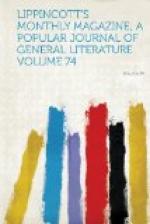Nor did this dilemma seem likely to decrease when we spied in the far distant windings of the road, dotted over with the receding black groups of priests and their supporters, a moving object approaching in our direction bearing unmistakable resemblance to the gig and broad-backed horse, but with a female figure seated behind Anton—a perplexity which grew greater when, the distance becoming less, the figure assumed a still more elegant form, holding a fashionable sunshade in her hand, which suddenly began to wave persistently in our direction.
Who could it be? We imagined, we hoped, we doubted, until ten minutes later our astonishment ended in a joyous reality as we clasped in our arms our dear, friend E——. She had arrived in our absence on a visit to us at the Hof, and the good family, desirous of affording us a joyful surprise, had proposed that Anton should drive her over to meet us at Nieder Olang. The Herr Student was in the secret. This had made him prudently cut our conversation short and return to his friends in the inn.
E—— brought bouquets of flowers for us from the aunt and Moidel, but there was no reason for us to hurry back: there were still several hours of daylight. The sturdy horse having already accomplished some eighteen or twenty miles since morning, made no objection to a rest and feed of hay in the stable, whilst Anton was content to sit with his brother and his two friends in the stube before the trio started on foot for the Hof. It seemed rather a desire to show the strangers the neighborhood than any inclination to attend the clerical meeting which had brought the Herr Student to Nieder Olang this afternoon. And we, glad of an hour’s delay, started immediately with E——, the sunny summer afternoon made brighter by this joyous meeting, to visit the adjoining hamlet of Mitter Olang.
The three small adjacent villages of Upper, Middle and Lower Olang, lying amongst monotonous fields and destitute themselves of any picturesque beauty, would be passed over by the stranger as totally devoid of interest; but, thanks to Dr. Staffler’s topographical work, Das deutsche Tirol und Voralberg, the mention of Peter Sigmair of Mitter Olang had excited a strong desire in us to see the spot where he had lived and died.
After the battle of Austerlitz, in 1805, the defeated emperor of Austria signed a treaty with Napoleon ceding Venice to the French and the Tyrol to their ally, Bavaria. The Tyrolese thus found themselves suddenly separated from an empire the fortunes of which they had shared for some five hundred years. If the country had outwardly become Bavarian, the hearts of the people remained essentially Austrian, and bitterly did they resent having to obey a government in league with the French, the sworn foe of Austria. Thus they determined on the first opportunity to throw off the hated yoke. The Bavarians had promised by the treaty to leave intact the Tyrolese constitution.




